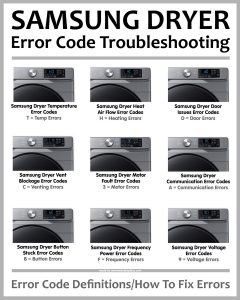
So, what exactly is this “E1” code? In simple terms, it’s your dryer’s way of telling you there’s a hiccup in the system — specifically with the thermistor. Don’t worry if that term sounds like something out of a sci-fi movie. Think of the thermistor as a thermostat’s cousin; it’s a tiny sensor that helps regulate the temperature inside your dryer. When it doesn’t work properly, your dryer sends out the E1 code as a cry for help. Let’s break down what this means and how you can handle it.
Understanding the Thermistor: Your Dryer’s Temperature Detective
The thermistor in your dryer is like a detective constantly on the lookout for temperature discrepancies. Just as a detective would sound an alarm if they discovered foul play, your dryer alerts you with an E1 code when the thermistor detects that something isn’t quite right with the temperature inside the drum. But why is this important? Well, proper temperature control is crucial for your dryer to work efficiently and safely. If the heat isn’t just right, clothes might not dry properly, or worse, there could be a risk of overheating.
When the E1 error code pops up, it’s usually because the thermistor is having trouble reading the temperature accurately. This might happen if the sensor is faulty or if there’s a poor connection somewhere. Imagine if your car’s speedometer suddenly stopped working — you wouldn’t know if you were driving safely within the speed limit. Similarly, a malfunctioning thermistor can lead to inefficient drying cycles or potential safety risks.
To check on your thermistor, you might need to open up your dryer, which can seem daunting. It’s a bit like opening the hood of a car; if you’re not used to it, it can be intimidating. But don’t worry, with a little patience and a few tools, it’s manageable. You might need to check the wiring or replace the thermistor if it’s faulty. Once you know the thermistor is back in working order, your dryer should function smoothly again.
Troubleshooting Steps: Bringing Your Dryer Back to Life
Now that we understand the basics, let’s dive into some troubleshooting. The first step is to unplug your dryer — safety first! We’re dealing with electrical components here, and we don’t want any unnecessary mishaps. Once it’s unplugged, give your dryer a quick inspection. Look for any obvious signs of damage or wear. Sometimes, the solution is as simple as fixing a loose wire or reconnecting a sensor. It’s a bit like untangling headphones; it takes some patience, but once they’re untangled, they work perfectly again.
If everything appears intact, the issue might lie within the thermistor itself. You can use a multimeter to test its resistance. This step can feel a bit technical, but think of it as using a thermometer. You’re checking to see if the readings match the expected values. If they don’t, it’s likely time for a replacement. Getting a new thermistor is like replacing a worn-out light bulb — once the new one is in, things should light up just as they should.
After you’ve replaced or repaired the necessary components, it’s time to test out your handiwork. Plug the dryer back in and run a test cycle. Fingers crossed, the E1 error code will be a thing of the past. If the code persists, it might be time to call in a professional. Sometimes, even the best detectives need a little help from more experienced colleagues!
Preventative Measures: Keeping the E1 at Bay
Now that your dryer is back in working order, let’s talk about keeping it that way. Regular maintenance can go a long way in preventing future issues. Think of it like taking your car for regular tune-ups; keeping everything in good shape helps avoid unexpected breakdowns. With your dryer, this can mean cleaning out the lint trap after every use and ensuring vents are clear and unobstructed.
Checking the thermistor regularly is also a good practice. Make it a habit to inspect it every few months, especially if your dryer is older. Imagine it like checking the batteries in your smoke detector. There’s peace of mind in knowing everything is working as it should be, preventing potential problems down the line.
Additionally, consider the environment around your dryer. A clean, well-ventilated space helps your appliance run efficiently. If your laundry area is crammed and dusty, it can lead to overheating issues, which in turn can trigger problems with the thermistor. A little tidying up in the laundry room can go a long way.
In conclusion, while the E1 error code might initially feel like an insurmountable challenge, with a little knowledge and perseverance, it’s a problem you can tackle. Remember, just like any good mystery, it’s all about piecing together the clues. With the right approach, your dryer will be back to keeping your clothes warm and dry in no time.